世界の航空史上でも、まれに見る最悪の事故と言われた・・・
『日本航空123便墜落事故』
あなたは、この事故にまつわる恐ろしい都市伝説を知っているだろうか・・・
日本人ならば誰でも、一度は耳にしたことのある、この事故の原因・・・
それは最終的に航空機の後部圧力隔壁を接続している金属の疲労によって引き起こされたと結論づけられた・・・
しかし、それは表向きだけの話で実際には別の原因があったのでは?!とまことしやかに噂されています・・・
はたして?!それは真実なのか?!
それとも、ただの都市伝説なのか?!

その疑惑の根拠として、語られている衝撃的な内容のアントヌーチ証言について全文を掲載していくぞい?!
前半は日本語に訳されたもので、後半は英文での証言内容をそのまま掲載しているぞい?!
【日航機墜落事故の闇・番外編】アントヌーチ証言【全文】

画像引用:newspaperarchive.com
【日航機墜落事故の闇】アントヌーチ証言・日本語訳全文
1995年8月27日「スターズ・アンド・ストライプス」紙面にて掲載の証言報道
【前文】
撤退命令が出ていなければ東京近郊の山中に墜落した日航123便事故の2時間後に、米海兵隊は生存者を救出できただろう。
【証言記事本文】
10年前の1985年8月12日に、日航123便は本州中部の山間に墜落し、520人が死亡した。
単独の航空機事故としては航空史上、最悪の犠牲者を出す結果となった。
日本の救助隊の現場への到達が遅れたのではないかとの論議が起こった。
最初の救助隊が日航機にたどり着いたのは墜落後12時間後だった。
実際、もし日本当局を困惑させまいとすることがなかったならば、最初の救助隊(米海兵隊チーム)は墜落後、2時間以内に墜落機の捜索ができていただろう。
生存者は4人だった。
(しかし)それ以上の多くの人が助かったかもしれない。
123便墜落事故の余波(被害拡大)について、私は独自の見方をしている。
事故当時、私はそのことについて「他言無用」の命令を受けていた。
しかし、大事故から10年経過した今、私があの晩 、東京から西に35マイル離れた横田基地に向かう米空軍C130のナビゲーターとして見たこと、聞いたことを、話さずにはいられない。
当時、私は横田基地の空軍中尉だった。
当日8月12日の午後6時30分ころ、我々は沖縄から横田に向け飛行中、大島上空にさしかかった。
われわれは最初、日航123便の機長が管制塔に緊急事態を宣言したときには、さして気にもしていなかった。
(なぜなら)軍では、緊急事態を宣言し、エンジンを止めて平穏無事に着陸することはよくあることだから。
しかし、6時40分ころ、再度、日航機長の声を聞いた。
その声は非常に動揺しており、管制とのやりとりは、航空の標準語である英語ではなく日本語だった。
こんなことは、几帳面な東京管制官の通常の離陸管制では考えられないほど異常なことだった。
ずっと後日になって知ったのだが、123便は(垂直)尾翼と下部方向舵の一部をなくしており、操縦不能であって、高濱雅巳機長はスロットルレバーの調整のみで操縦し、高度を変えようとしていた。
また123便は緊急降下が必要な緊急事態である急減圧が起きていた。
同機は絶望的な状態だったのだ。
われわれは、周波数を横田基地に切り替え、オオクラでホールディングするよう指示された。
旋回中に、横田管制が123便に横田基地への着陸を許可するのを聞いた。
このときから、われわれは事態を真剣に注視するようになった。
123便の緊急事態は相当に深刻で、目的地に到着できそうになかった。
だから、めったにないことだが、当該乗員は米軍基地への着陸を希望したのだった。
横田管制は123便と交信しようとしていたが駄目だった。
われわれにも(横田基地への)進入許可を出したが、ちょうど7時過ぎに123便がレーダーから消えた、と伝えてきた。
そして123便を捜索できないかと聞いてきた。
われわれは、あと2時間は飛べる燃料を持っていたので機首を北に向け、捜索に向かった。
管制では123便がレーダーから消えた場所をよく分かっていなかった。
当機は、陽が長くなった夏の夕日が沈みかけていたころ、機首を北北西に進路を取った。
午後7時15分、航空機関士が1万フィート付近で雲の下に煙のようなものが見えるのを発見したので、ゆっくり左に旋回し、そちらへ方向を向けた。
御巣鷹山の周辺はとても起伏が多かった。
地表からおよそ2000フィートまで降下する許可を得た。
墜落機残骸を発見したのは、あたりはだんだんと暗くなり始めていた時だった。
山の斜面は大規模な森林火災となり、黒煙が上がり、空を覆っていた。
時刻は7時20分だった。
当機の指揮官、ジョン・グリフィンは、墜落機残骸の上空2000フィートで旋回していた。
私は地上との高度をモニターし、横田までの位置関係を確認した。
事故現場から横田までの緯度、経度、方向と距離を連絡した。
墜落後、およそ20分で当局は墜落機残骸の位置をつかんでいたのだ。
横田管制から、我々の現在地から約40マイルの厚木基地から、米海兵隊が救難に向かう準備をしてることを聞いた。
1時間で到着できただろう。
副操縦士のゲーリー・ブレイは管制に「海兵隊に急ぐように伝えてくれ。もっとも生存者がいるかどうかは疑問だがね]といった。
管制官からは「生存者はいない様子。了解」との返答があった。
「ここからでは生存者がいるかどうか分からないのに、あんなこというんじゃなかった」とゲーリーは無線を外して私にそういった。
当機は8時30分まで先回を続けた。
そのとき、海兵隊のヘリコプターが救助に向かっているので方向を知りたがっている、といわれたので、墜落現場までの方位を教え、当機のレーダーで地上から空中までを探してみた。
8時50分までに救援ヘリのライトを視認できた。
ヘリは偵察のため降下中だった。
午後9時5分に、煙と炎がひどくてとても着陸できないと海兵隊が連絡してきた。
位置を少し移動して二人の乗員をホイスト(ウインチで吊り下げ)で地上に降ろすつもりでいた。
われわれに、司令部に連絡してくれと頼んできた。
私が司令部に連絡を取った。
将校は「直ちに基地へ帰還せよ」「日本側が向かっている」といったので「司令部、海兵隊は救助続行をきぼうしている」といったが、「繰り返す。即刻、基地に帰還せよ。海兵隊も同様」と命令された。
私は「了解。基地に帰還する」と応答した。
ブレイは渋々そのことを海兵隊に知らせた。
海兵隊も了解しており、引き上げ始めていた。
われわれの到着から2時間経過した午後9時20分に、最初の日本の飛行機が現れた。
管制から日本の救難機だとの知らせを受けた。
日本側が現場に到着したことで、安心してその場を引き上げた。
もっとも、我々の燃料もほとんど使い果たしていた。
横田基地に引き返し、着陸後直ちに司令部に報告するように指令を受けた。
我々を待っていたのは、第861戦術飛行隊副司令官、ジョエル・シルズ大佐であった。
グリフィン機長が経過を簡単に報告した後、大佐は「ご苦労だった。今回のことについてマスコミには一切他言無用」といった。
われわれは、緊張を強いられた17時間にも及ぶ飛行を終え、休息をとるために飛行中退のビルに向かった。
そのとき、日航123便が満席に近い500人以上もの乗客を乗せていたことを日本のテレビを見て知った。
起こった事故の大きさに驚き、声も出なかった。
スケジューラーが翌日の午後、一週間の任務で沖縄へ出発するようにとの指令をわれわれに伝えたので、その静寂が終わった。
乗務員はそのまま放置されたが、そんなことは通常ないことであった。
翌日のニュースや新聞を見て、われわれは愕然とした。
ニュースは、日本の捜索隊が墜落地点を発見するのが、いかに困難をきわめたかを伝える報道で溢れていた。
事実、まだ事故機残骸に到着していなかった。
私はすぐに地図のところへ行って昨日の航跡を確認した。
私には正確な位置を示した、という自信があった。
私は海兵隊のヘリコプターに墜落地点までの飛行を無線で誘導したのだし、日本の救難機が墜落現場上空に到着して旋回しているのを確認した後に、帰還したのだから。
あの事故機発見がそれほど困難をきわめるような問題が日本側にあったのだろうか?
墜落から2週間たって、タイの首都、バンコクにいたとき、私は墜落の写真が表紙になった『タイム』と『ニューズウィーク』を買った。
これで4人の生存者がいたことを初めて知った。
4人のうちの落合由美さんの記事を読んでゾッとさせられた。
彼女は墜落後、意識があったときのことを語っている。
残骸の下で動けなかったが、彼女はヘリコプターを発見し、手を振って合図したが、すぐには返答がなかった。
「次第に私は眠くなった」「気がつくと男の人の話し声が聞こえ、もう朝だった」と彼女はいっている。
落合さんはまた、看護師に、数人の子どもたちの声を聞いたが闇の中でその声は次第に途絶えていった、と話している。
私は打ちのめされたような気がした。
海兵隊が吊り上げによる救助を許可されていたならば、さらに数人の生存者を救出できたのにと考えざるを得なかった。
海兵隊のヘリコプターは、落合由美さんが見つけられるところまで接近していたのだ。
『ニューズウィーク』誌によると、日本の当局は、捜索開始命令が午後9時30分まで出されなかった、と述べている。
(しかし)その時刻はわれわれが墜落地点を確認した2時間後だった。
最初の日本のヘリコプターが現場にやっと到着したのは、翌日の午前4時40分だった。
午前7時15分になって日本の捜索隊は、警察(自衛隊のこと)のレンジャー部隊をヘリコプターで吊り下ろすことを決断した。
海兵隊のヘリコプターが同じことをやろうとして許可されなかったときから、11時間もたってのことだった。
こういう大惨事での米国の役割については、『タイム』や『ニューズウィーク』誌でも、われわれのC130や海兵隊の行動を報道することはなく、記者たちは日本の当局が公表したことを鵜呑みにしている。
『ニューズウィーク』は、日本のF4戦闘機が午後7時21分に山の中の炎上地点を確認したと伝えていた。
当時の日本はF4を持っていなかったし、在日米軍基地にもF4は配備されていなかったという事実を除けば、これはよくできた話である。
また『タイム』は、日本の航空自衛隊が派遣した2機の航空機が、炎上地点を確認したと伝えている。
このことは、午後9時30分まで捜索命令が出されなかった、という軍(自衛隊)の前述の言明と矛盾している。
夜から朝にかけて、いったい何が起こっていたのだろうか。
日本の救助隊は、墜落現場から42マイル離れた上野村に対策本部を設置しつつあった。
後になって、日本の緊急事態対策問題に精通しているある人から、彼らが1機ではなく2機の米軍機が自分たちよりも2時間も早く現場に到着していたことに、びっくりしていた、と聞かされた。
この人物は「日本の乗員は、あなた方が行ったようにとっさに捜索を実行するなんてことは絶対できないだろう」「彼らの救助活動のやり方といえば、マニュアルなど文字になっているものでしかできないのだ。しかし、あなたたち(空軍と海兵隊)はそれを見事にやってのけた」と私に語った。
(※42マイル(約65km)は4.2マイルの誤りと思われる)
私が日本に戻ってきたころには、この話は立ち消えになっていた。
われわれ乗員たちは、ある連絡(承諾)を受け取ったが、われわれの期待とはずいぶん、かけ離れていた。
われわれは、日本の新聞に残骸の写真を売るための空軍特別調査活動の任務にあった、ということにされた。
しかし、この調査は、当然のことながらあっという間に終わった。
なぜならフィルムを持っているものなどだれ一人いなかったし、写真を取れるような明かりも十分なかったのだから。
そのうえ、マスコミは、われわれがそこを飛んでいたことなど、誰も知らないのだから、報道されるはずもなかった。
1987年3月、私は横田基地を離れ、サクラメントのマザー空軍基地で航法教育に携わる大尉として着任したが、そのとき、空軍表彰メダルを授与された。そこにはこう書いてある。
「アントヌッチ大尉とその乗務員は、日航機の捜索を決定し、直ちに捜索計画をたて、墜落現場を発見し、救助隊を現地に誘導した」
私は空軍が私たちの行動を認めてくれたことは嬉しかったが、表彰を喜ぶ気になれない。
私は「まだ、生存していた人たちを救出できなかった」と付け加えたかった。
日航123便事故は、実際二つの惨事がある。
第一は墜落事故の衝撃で人々が死亡したことである。
第二には、遺体収容を援助した医師たちの証言に表れている。
つまり、もっと早く救助隊が到着していれば、負傷者、または致命的でなかった乗客を発見できただろうということだ。
ある医師の証言は私の体の心まで震え上がらせた。
彼は「もし、発見がもう10時間早ければ、われわれはもっと多くの生存者を発見できたであろう」といっている。
【日航機墜落事故の闇】アントヌーチ証言・英文記事全文
Michael Antonucci “Pacific Stars and Stripes” August 27, 1995
1985 air crash rescue botched, ex-airman says
Had they not been ordered away, U.S. Marines could have been helping survivors two hours after JAL 123 crashed in mountains near Tokyo.
Michael Antonucci served in the Air Force from 1982 to 1990. He is currently managing editor of Inside California magazine in Sacramento, Calif. Reprinted with permission from The Sacramento Bee and Michael Antonucci.
BY MICHAEL ANTONUCCI
Special to Stripes
Ten years ago, on Aug. 12, 1985, Japan Airlines Flight 123 crashed into the mountains of central Honshu, resulting in the deaths of 520 people. It was the worst loss of life involving a single aircraft in the history of aviation.
A controversy arose because of the delay in getting to the wreckage by Japanese rescue workers. The plane had been down for 12 hours before the first rescuers reached the scene. In fact, had it not been for efforts to avoid embarrassing Japanese authorities, the first rescuers – a team of U.S. Marines – could have been searching the wreckage less than two hours after the crash. Four people survived. Many more could have.
I have a unique perspective of the aftermath of that crash. At the time it occurred, I was ordered not to speak about it. But on the 10th anniversary of the disaster, I feel compelled to tell what I saw and heard that evening as the navigator on a U.S. Air Force C-130 inbound to Yokota Air Base, 35 miles west of Tokyo.
I was a first lieutenant stationed at Yokota. At about 6:30 p.m. on that Aug. 12, we were approaching Oshima Island on a flight to Yokota from Okinawa. When we first heard the pilot of JAL 123 declare an emergency to air traffic control, we took little notice of it. In a C-130, you often declare an emergency, shut down an engine and land uneventfully. But at about 6:40, we heard the JAL pilot again. This time his voice was very agitated, and he was speaking to the controller in Japanese rather than English, the international language of aviation. This was a very unusual departure from standard operating procedure by the meticulous Tokyo controllers.
I discovered much later that JAL 123 had lost most of its rear stabilizer and a portion of its lower rudder. The aircraft was uncontrollable, the pilot, Capt. Masami Takahama, was attempting to steer and change altitude by throttle adjustments alone. JAL 123 had also experienced a rapid decompression – an emergency requiring an immediate descent. JAL 123 was in a no-win situation.
We switched frequencies to Yokota Approach Control and were advised to enter a holding pattern at Okura. While in the pattern, we heard Yokota Approach clear JAL 123 for landing at the base. At this point, we really began to pay attention. The in-flight emergency was so bad the airliner could not reach the destination. The pilot wanted to land at a U.S. military base – an extraordinary event.
Crash: Japanese took 12 hours to reach site
We heard Yokota Approach try to contact JAL123 with no success. They cleared us for an approach, but just after 7 p.m. advised us that radar contact with JAl 123 had been lost and asked if we could begin a search. We had enough fuel for another two hours of flying time. We headed north.
The tower did not have a good idea of where JAl 123 was last seen. We started out heading north-northwest as the sun was setting on that long summer day. At 7:15, the flight engineer spotted what looked like smoke under a cloud base at about 10,000 feet. We made a slow left turn and headed for it. The area around Mount Osutaka was very rugged. We received clearance to descend to roughly 2,000 feet above the terrain. It was starting to get dark when we spotted the wreckage. On the side of a ridge was a huge forest fire with a plume of dark smoke rising and obscuring the sky. The time was 7:20 p.m.
John Griffin, our aircraft commander, established himself in a holding pattern 2,000 feet above the wreckage. I monitored our terrain clearance and fixed our position in reference to Yokota. I passed both latitude and longitude coordinates and a bearing and distance from Yokota to the site. Roughly 20 minutes after the crash, authorities had the location of the wreckage.
Yokota Approach told us that a Marine rescue team was preparing to launch from Atsugi Naval Air Station, about 40 miles from our position. They would be there in an hour.
“Tell them to hurry,” said our co-pilot, Gary Bray, “but I doubt if there will be any survivors.” The controller replied, “Roger, no sign of survivors.” When Gary got off the radio he said to me; “I shouldn’t have said that. We can’t tell from here.”
We continued to fly an oval pattern until about 8:30 p.m. We were then informed that the Marine helicopter was on its way and wanted directions. I passed a general heading to them and configured my radar from ground to air. By 8:50 p.m. we had the helicopter’s lights in sight. They were going down to look.
At 9:05 p.m. the Marines radioed that the smoke and flames were too dense to attempt a landing. They were willing to move off a bit and have two crewmen rappel to the ground. They asked us to contact command post. While Bray spoke with the Marines, I radioed the command post.
“You are to return to base immediately,” the duty officer said, “The Japanese are on the way.” “The Marines want to go in, command post,” I told him. “Repeat, you are to return to base immediately, and so are the Marines,” he ordered. “Roger, return to base,” I replied.
Bray reluctantly passed the news to the Marines, who acknowledged and began to climb away. At 9:20 p.m., two hours after our arrival, the first Japanese aircraft arrived on the scene. Approach Control confirmed for us that it was a Japanese rescue plane. With the Japanese on the scene, we felt safe leaving. Besides, we had just about used up our fuel.
We turned back to Yokota and landed with the message that we were to report to the command post immediately. Waiting for us was the deputy commander of the 816th Tactical Airlift Group, Col. Joel Sills. After Griffin gave him a short recap of our actions, Sills said; “You guys did a fine job. You are not to talk to the media about any of this.”
We headed over to the squadron building to check in, our last stop after a stressful 17-hour crew day. It was only then that we discovered from Japanese television that JAL 123 was a modified high-capacity passenger plane with more than 500 people aboard. The enormity of what had happened struck us then and it got very quiet. The silence was broken when the scheduler told us that we were to leave the next afternoon on a week-long mission to Okinawa. The crew was left intact, which was unusual.
Watching the news and reading the papers the next day baffled us a bit. The news was filled with reports about how the Japanese had had difficulty finding the site and in fact had yet to reach the wreckage. I immediately went to my chart to check my work. I was confident that I had given the right location. I had vectored the Marine helicopter to the spot. And we left the Japanese aircraft circling over the area. How could they have trouble finding the wreckage?
Two weeks after the crash, while in Bangkok, Thailand, I bought copies of Time and Newsweek with pictures of the crash on the cover. It was the first time I had read there were four survivors. I was horrified to read the account of Yumi Ochiai, one of the four. She described being conscious after the crash. Pinned down by wreckage, she saw a helicopter and waved. There was no immediate response. “Gradually, I slept,” she said. “I heard men talking, and it was morning.”
Ochiai also told a nurse that she had heard several children’s voices that gradually faded away during the night. I was frustrated and furious to think that had the Marines been allowed to rappel in, they might have saved a few more lives. The Marine helicopter had been close enough for Yumi Ochiai to see it.
According to Newsweek, Japanese authorities claimed that orders to begin a search did not arrive until 9:30 p.m., more than two hours after we had already spotted it. The first Japanese helicopter did not overfly the area until 4:40 the next morning. At 7:45 a.m., the Japanese decided that it would be a good idea to rappel a police ranger from a helicopter to the ground – almost 11 hours after the Marines had been denied permission to do so.
As for the U.S. role in this tragedy, neither Time nor Newsweek mentioned our C-130 or the Marines – but reporters accepted the version passed to them by Japanese authorities. Newsweek reported that a Japanese F-4 fighter plane spotted a fire in the mountains at 7:21 in the evening. A reasonable story – except that the Japanese had no F-4s and there were no American F-4s in Japan that day.
Time reported that two planes dispatched by Japan’s Air Self-Defense Force spotted the flames. This directly contradicted the military’s previous statement that they were not told to search until 9:30 p.m.
What was going on during the night and well into the morning? The Japanese rescuers were “setting up a base” in the village of Uenomura, 42 miles from the crash site, I was later told by someone familiar with Japanese emergency management that they were upset that not one, but two American aircraft had made it to the scene two hours before theirs.
“A Japanese crew could never have decided on the spur of the moment to go search the way you did,” this person said. ” And the rescue effort had to be organised according to the book, You and the Marines just went.”
By the time I got back to Japan, the story had died down. My crew did receive some recognition – but not what we expected. We were told we were under investigation by the Air Force Office of Special Investigation for selling photos of the wreckage to Japanese newspapers. The investigation, of course, was short-lived because no one on board had any film to sell, nor would there have been enough light to take pictures. Besides, the news media reports were evidence that no one knew we had been there.
In March 1987, after I had transferred from Yokota and was a captain giving navigation instruction at Mather Air Force Base in Sacramento, I received the Air Force Commendation Medal. The citation accompanying the award read in part; “Captain Antonucci and crew were diverted to search for a downed Japan Airlines flight, the worst Japanese aviation disaster in history. He quickly established a search plan, found the crash site and vectored rescuers to the scene.”
I was glad to have the Air Force acknowledge what we had done, but the commendation brought me no joy. I wanted to add, “No additional lives were saved.”
The crash of JAL 123 was in reality two tragedies. The first was the deaths of those killed on impact. The second was described by doctors who helped retrieve the bodies. They found some whose injuries might not have been fatal had help come more quickly.
The words of one physician chilled me to the bone. “If the discovery had come 10 hours earlier,” he said, “we could have found more survivors.”
( Antonucci was assigned to the 345th Tactical Airlift Squadron at Yokota Air Base when JAL 123 crashed. In a telephone interview last week with Pacific Stars and Stripes, he said he had been told after the crash to refer all questions about it to public affairs officers. “Nobody ever told us why we couldn’t talk about it,” he said. The C-130 was carrying two extra hours of fuel because a Kadena Air Base ground crew had initially loaded too much, and with a typhoon evacuation in progress, the flight crew chose to depart rather than unload the excess fuel, Antonucci said. Antonucci said he has not kept in touch with his former flight crew. The Sacramento Bee said a Pentagon spokesman for the Air Force declined to confirm or deny Antonucci’s report, and the Bee said the Japanese Embassy in Washington did not respond to its requests for comment. )
【日航機墜落事故の闇・番外編】アントヌーチ証言【全文】:あとがき

凄い内容ではないかの~?(汗)
改めてみると凄い内容だよね(汗)
定説では朝まで墜落地点が発見出来なかったってことになってるけど、このアントヌーチ証言をみると、墜落から2時間後には場所が特定されていて、日本側の救難機も到着してたって言うんだからね(汗)
これじゃあ、この都市伝説で語られる3つ目の疑惑・・・
「墜落場所は発見出来なかったのではなく、あたかも発見が困難であるかのように偽装したのではないか?」
「そんなことをした理由は、本当の事故原因を隠蔽するための時間稼ぎをしたかったからではないか?」
この疑惑を裏付けるかのような内容になってるわけだしね(汗)


ホントにこの日航機墜落事故はどこまで闇が深いのか(汗)
と言うことで、今回もいつものように・・・
「信じるか信じないかはあなた次第です!」
と言った感じじゃぞい?!
次回も絶対、見に来てくれよな!


ブログランキングにも参加中ですじゃ!
↓良ければポチッとお願いしますぞ!
書き続けるためのモチベーションアップにつながるので、是非ともよろしくですじゃ!
↓↓↓次にオススメの記事!↓↓↓




